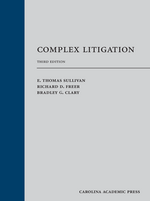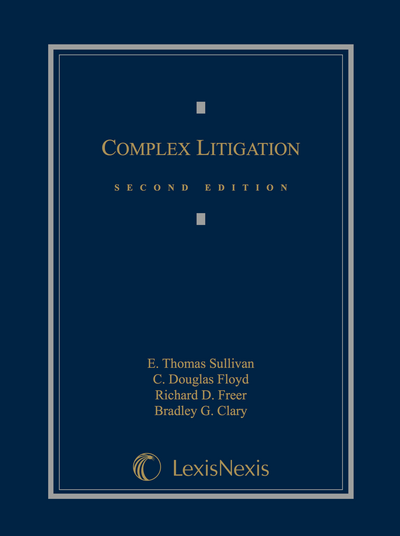This book has been replaced by a newer edition:
Complex Litigation, Third Edition
by E. Thomas Sullivan, Richard D. Freer, Bradley G. Clary
2019, 802 pp, casebound, ISBN 978-1-5310-1105-5
$205.00
Teacher's Manual available
Complex Litigation
Second Edition
by E. Thomas Sullivan, Douglas Floyd, Richard D. Freer, Bradley G. Clary
2014
Tags: Civil Procedure, Complex Litigation, Litigation
Teacher's Manual available
960 pp $186.00
ISBN 978-1-63044-780-9
eISBN 978-1-63044-782-3
To access the 2018 supplement, click here.
This unique coursebook has a number of distinguishing features. First, unlike traditional casebooks with their primary focus on case materials, the text presents a limited number of leading cases, coupled with extensive textual and note material reviewing existing doctrine and exploring unanswered legal and policy issues. Second, the text is current on cutting-edge issues while still paying attention to the fundamentals. Third, the text is both compact and comprehensive. This text aims to be state-of-the-art in the field of complex litigation and is designed for use in ether two- or three-unit courses.
In addition to structural issues, such as Internet jurisdiction, the use of "minimal diversity" as a basis for federal jurisdiction, and mechanisms for the coordination of overlapping federal and state litigation, the text contains in-depth discussion of: The most recent developments in class action practice under Federal Rule 23; appointment and compensation of lead and class counsel; operation of the multidistrict statute; choice of law issues in multijurisdictional cases; and preclusion issues raised by complex cases, including limits on the use of non-party preclusion under the Supreme Court's decision in Taylor v. Sturgell.
The text also examines core aspects of the complex litigation process itself, including judicial management of the pre-trial process, the conduct and control of discovery with a focus on the burgeoning field of electronic discovery including metadata, and mechanisms for disposing of cases without trial, including comprehensive treatment of the Supreme Court's recent decisions facilitating dismissal of cases on the pleadings, and the increasing prevalence of arbitration and waivers of class arbitration.
A comprehensive Teacher's Manual is available to professors.
This book also is available in a three-hole punched, alternative loose-leaf version printed on 8.5 x 11 inch paper with wider margins and with the same pagination as the hardbound book.



